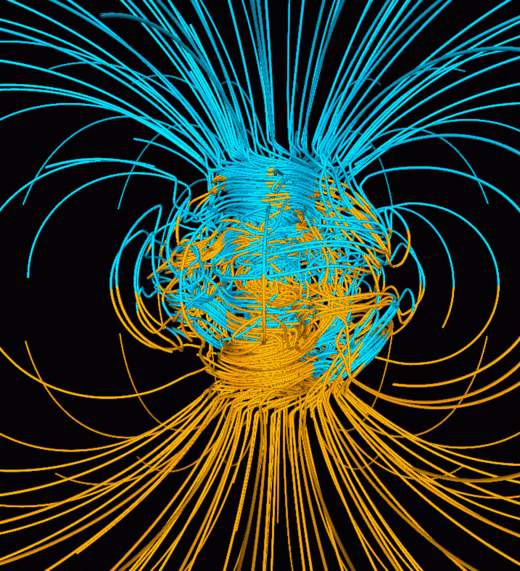
Unfortunately, magnetic-field strength is now declining rapidly.**
_______
New fossil finds, improved fossil dating, knowledge of the past strength of Earth's magnetic field, and refinements in the human evolutionary tree, suggest a link between ultraviolet radiation (UVR), magnetic field strength, and mammalian evolution, says a new paper by Channell and Vigliotti.
The earth's magnetic field shields us from galactic cosmic rays and solar wind, and from harmful UVR. During magnetic reversals, that protection declines.
Over approximately the last 200,000 years, evolutionary changes corresponding to low geomagnetic-field strength support the proposition that UVR that can affect mammalian evolution by influencing DNA and Y chromosomes.
The demise of the Neanderthals about 41,000 years ago can be closely tied to low magnetic-field strength during the Laschamp magnetic excursion, and the survival of anatomically modern humans can be attributed to the evolutionary response to UVR flux.
Fossils in Australia and Eurasia from about 40,000 years ago, close to the Laschamp and Blake magnetic excursions, record an important die‐off of large mammals that included Neanderthals in Europe.
In the Americas and Europe, a large mammalian die‐off occurred about 13,000 years ago. Both die‐offs can be linked to low magnetic field strength implying that UVR flux variations to Earth's surface influenced mammalian evolution.
Magnetic excursions have been named after the location where they were initially recorded such as Mono Lake (34 ka), Laschamp (41 ka), Blake (~115 ka), Iceland Basin (190 ka), and Pringle Falls (211 and/or 238 ka).
At least seven magnetic excursions have been documented in lavas and sediments of the last 300,000 years.
See entire 43-page paper, "The Role of Geomagnetic Field Intensity in Late Quaternary Evolution of Humans and Large Mammals:"
https://agupubs.onlinelibrary.wiley.com/doi/full/10.1029/2018RG000629
Thanks to Richard Allen for this link
** Note: When I wrote Not by Fire but by Ice, the earth's magnetic field strength had been declining five percent per century. Now it's declining five percent per decade!



Ok